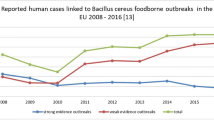Abstract
We document here that in those rare cases where disease has been related to Bacillus licheniformis, infection was associated with bypassing the normal biological protective barriers or severely debililated patients. No case suggests any invasive properties of this bacterium. B. licheniformis can therefore be considered non-pathogenic to humans in general. Food-borne illness caused by possible B. licheniformis toxins have been reported, but only in a very few cases and only in connection with consumption of inappropriately prepared food. Considerable experience concerning the industrial use of recombinant B. licheniformis strains has now accumulated and authorities in the United States, Europe and Japan have approved production with and products from recombinant B. licheniformis strains. We conclude that B. licheniformis is a safe host for the production of harmless, industrial products.
Similar content being viewed by others
References
Andreoli PM, Lenson PJ, Simonette ALM, Vos YJ (1988) Bacillus licheniformis as a host for heterologous gene expression. In: Breteler H, van Levyveld PH, Luyben KChAM (eds) Proceedings of the 2nd Netherlands Biotechnology Congress. Netherlands Biotechnological Society, Zeist, the Netherlands, pp 151–155
Ash C, Farrow JAE, Wallbanks S, Collins MD (1981) Phylogenetic heterogeneity of the genus Bacillus as revealed by comparative analysis of small sub-unit-ribosomal RNA sequences. Lett Appl Microbiol 13:202–06
Banerjee C, Bustamante CI, Warton R, Talley E, Wade JC (1988) Bacillus infections in patients with cancer. Arch Intern Med 148:1769–1774
Barbesgaard P, Heldt-Hansen HP, Diderichsen B (1992) On the safety of Aspergillus oryzae. A review. Appl Microbiol Biotechnol 36:569–572
Boer Anne Sietske de, Diderichsen B (1991) On the safety of Bacillus subtilis and B. amyloliquefaciens. A review. Appl Microbiol Biotechnol 36:1–4
Cotton DJ, Gill VJ, Marshall DJ, Gress J, Thaler M, Pizzo PA (1987) Clinical features and therapeutic interventions in 17 cases of Bacillus bacteraemia in an immuno suppressed patient population. J Clin Microbiol 25:672–674
Diderichsen B, Poulsen GB, Jørgensen PL (1991) Cloning and expression of a chromosomal alpha-amylase gene from Bacillus stearothermophilus. Res Microbiol 142:793–796
EPA (1987) (Environmental Protection Agency of the United States). Premanufacturing Notices PMN 87–1511
EPA (1989) (Environmental Protection Agency of the United States). Premanufacturing Notices PMN 89-1071
Fauchere JL, Berche P, Ganeval D, Daniel F, Bournerias F, Daoulas-Lebourdelles F, Veron M (1977) Une septicémie á Bacillus licheniformis. Méd Maladies Infectieuses 7:191–195
FCC (1981) Food Chemical Codex, 3rd edn. National Academy Press, Washington
FDA (1983) (Food and Drug Administration) 21 CFR 184.1027. Fed Reg Vol 48:329–340
FDA (1991) (Food and Drug Administration) GRASP OGO363. Fed Reg Vol 56:324–35
Fiechter A (1992) Biosurfactants: Moving towards industrial application. Trends Biotechnol 10:208–217
Gordon RE, Haynes WC, Pang CHN (1973) The genus Bacillus. United States Department of Agriculture, Washington, D. C.
Hardy A, Christmann D, Feger JM, Pasquali JL, Storck D (1986) Etat septique apres artériographie. Du rôle d'un germe réputé non pathogéne: Bacillus licheniformis. Méd Maladies Infectieuses 1:37–38
Kramer JM, Gilbert RJ (1989) Bacillus cereus and other Bacillus species. In: Doyle MP (ed) Foodborne bacterial pathogens, Dekker, New York, pp 21–70
Leen RW van, Bakhuis JG, Beckhoven RFWC von, Burge M, Dorssers LCJ, Hommes RWJ, Lemson PJ, Noordam B, Persoon NLM, Wagemaker G (1991) Production of human-interleukin-3 using industrial microorganisms. Biotechnology 9:47–52
MITI (1988) (Ministry of International Trade and Industry in Japan). Certificate No. 63:134
Nakamura LK (1989) Taxonomic relationship of black-pigmented Bacillus subtilis strains and proposal for Bacillus atrophaeus sp. nov. Int J System Bacteriol 39:295–300
NIH (1988) (National Institute of Health) Guidelines fro Research Involving Recombinant DNA Molecules. Fed Reg Vol 53 No 207:43410–43411
NIH (1991) (National Institutes of Health) Recombinant DNA Research: Actions under the Guidelines (for Level of Containment Appropriate to Good Industrial Large Scale Practices (GILSP)). Fed Reg Vol 56, No 138:33174–33183
OECD (1986) (Organisation for Economic Co-operation and Development) Recombinant DNa safety considerations. Paris
Pearson HE (1970) Human infections caused by organisms of the Bacillus species. Am J Clin Pathol 53:506–515
Peloux Y, Charrel-Taranger C, Gouin F (1976) Nouvelle affection opportuniste a Bacillus: un case de bactériémie a Bacillus licheniformis. Pathol Biol 24:97–98
Priest FG (1989a) Products and applications. In: Harwood CR (ed) Biotechnology handbooks, vol 2. Bacillus. Plenum, New York, pp 293–320
Priest FG (1989a) Isolation and identification of aerobic, endospore-forming bacteria. In: Harwood CR (ed) Biotechnology handbooks, vol 2. Bacillus. Plenum, New York, pp 27–56
Priest FG, Goodfellow M, Shute LA, Berkeley RCW (1987) Bacillus amyloliquefaciens sp. nov. nom. rev. Int J Syst Bacteriol 37:69–71
Seki T, Oshima I (1989) Taxonomic position of B. subtilis. In: Maruo B, Yoshikawa H (eds) Bacillus subtilis: molecular biology and industrial applications. Elsevier, Amsterdam, pp 7–21
Shamsuddin D, Tuason C, Levy C, Curtin J (1982) Bacillus cereus panophthalmitis: source of the organism. Rev Infect Dis 4:97–103
Sliman R, Rehm S, Shlaes DM (1987) Serious infections caused by Bacillus species. Medicine 66:218–223
Sugar AM, McCluskey RV (1977) Bacillus licheniformis sepsis. J Am Med Assoc 238:1180–1181
Tabbara KF, Tarabay N (1979) Bacillus licheniformis corneal ulcer. Am J Ophthalmol 87:717–719
Thurn JR, Goodman JL (1988) Post-traumatic ophthalmitis due to Bacillus licheniformis. Am J Med 85:708–710
Tuazon CU, Murray HW, Levy C, Solney MN, Curtin JA, Sheagren JN (1979) Serious infections from Bacillus species. J Am Med Assoc 241:1137–1140
Young RF, Yoshimoni RN, Murray DL, Chou PJ (1982) Postoperative neurosurgical infections due to Bacillus species. Surg Neurol 18:271–273
Author information
Authors and Affiliations
Additional information
Correspondence to: B. Diderichsen
Rights and permissions
About this article
Cite this article
de Boer, A.S., Priest, F. & Diderichsen, B. On the industrial use of Bacillus licheniformis: a review. Appl Microbiol Biotechnol 40, 595–598 (1994). https://doi.org/10.1007/BF00173313
Received:
Accepted:
Issue Date:
DOI: https://doi.org/10.1007/BF00173313




